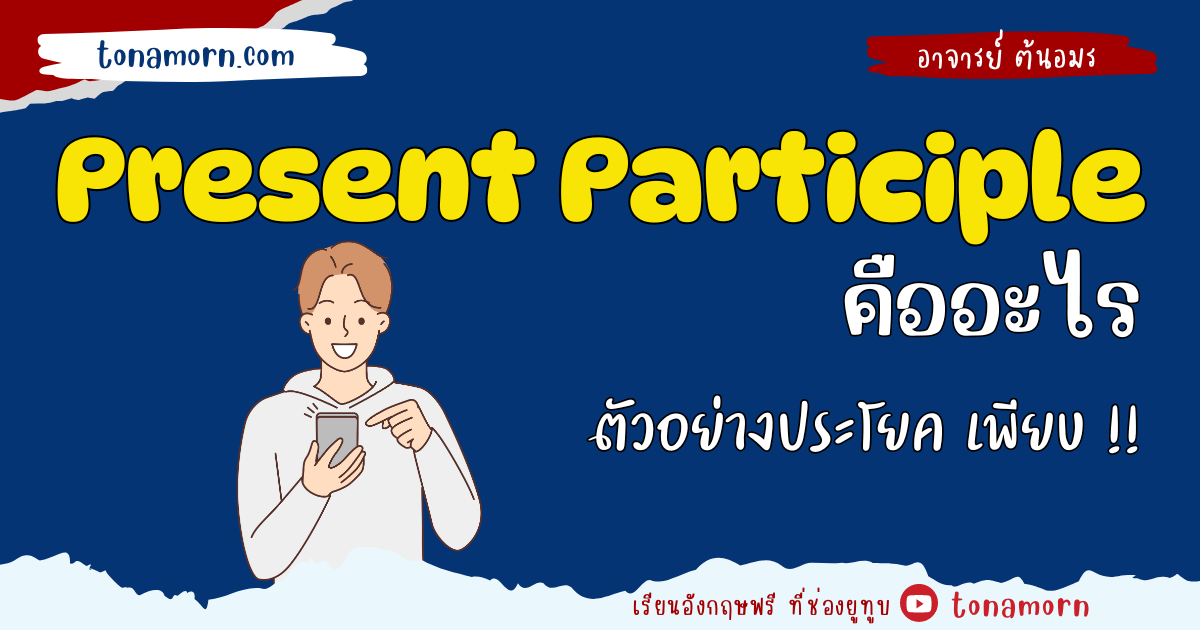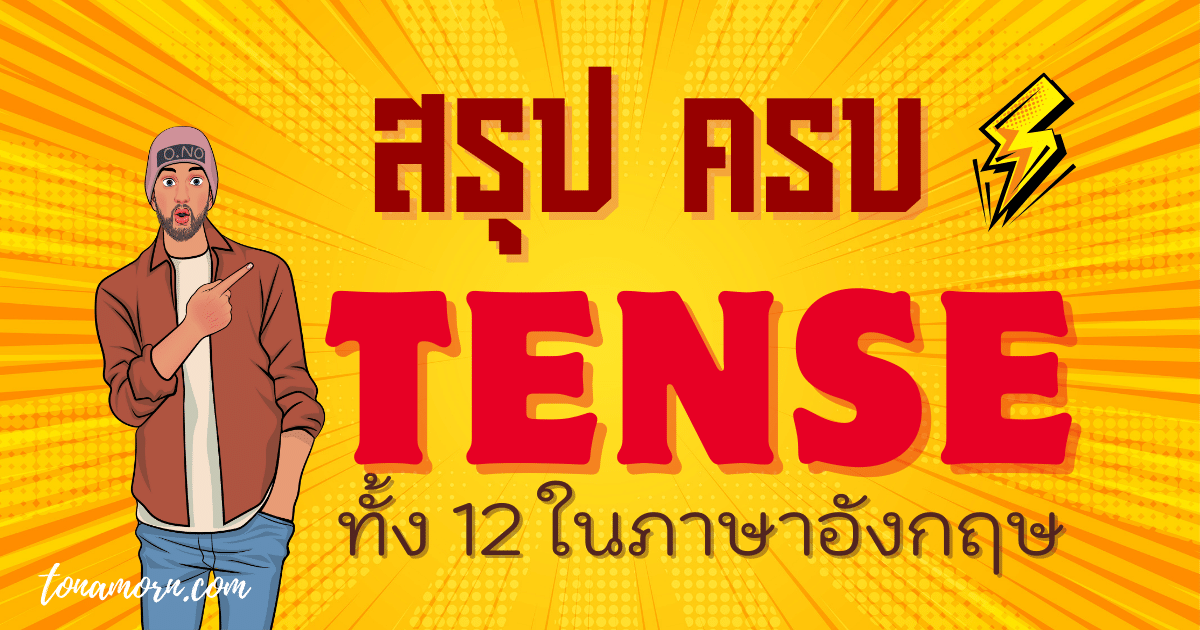สรุป Present Participle คืออะไร ตัวอย่างประโยค

Present Participle
เข้าใจ “Present Participle” กุญแจสู่ภาษาอังกฤษที่สื่อความหมายได้ลึกซึ้ง
“Present Participle” หรือ “กริยาเติม -ing” คือ รูปแบบกริยาภาษาอังกฤษที่ทรงพลัง ช่วยให้การสื่อสารของคุณมีมิติและความซับซ้อนมากขึ้น บทความนี้จะพาคุณไปไขความลับของ “Present Participle” ว่าคืออะไร มีหน้าที่อย่างไร และใช้ในสถานการณ์ใดบ้าง
“Present Participle” คืออะไร?
ง่ายๆ เลยก็คือ กริยาที่เติม “-ing” ลงท้าย เช่น “walk” กลายเป็น “walking” “talk” กลายเป็น “talking” “eat” กลายเป็น “eating” แต่ “Present Participle” ไม่ได้แปลว่า “ปัจจุบัน” เสมอไป
“Present Participle” มีหน้าที่อะไร?
- เป็นกริยา: ใช้สร้างประโยคกริยาต่อเนื่อง (Continuous Tenses) เช่น “I am walking” “They are talking” “We are eating”
- เป็นคุณศัพท์: อธิบายลักษณะของบุคคล สิ่งของ หรือสถานที่ เช่น “a walking stick” “a talking dog” “a delicious meal”
- สร้างประโยค Participle Phrase: อธิบายเพิ่มเติมเกี่ยวกับประโยคหลัก เช่น “Walking down the street, I saw a talking dog.”
“Present Participle” ใช้ในสถานการณ์ใดบ้าง?
- อธิบายว่ากำลังทำอะไรอยู่: “I am watching a movie.”
- อธิบายว่าทำอะไรพร้อมกัน: “I am listening to music while I cook dinner.”
- อธิบายสาเหตุ: “Being tired, I went to bed early.”
- อธิบายวิธีการ: “Opening the door, I walked inside.”
- อธิบายลักษณะ: “Having a long tail, the cat looked like a dog.”
“Present Participle” กับ “Past Participle” ต่างกันอย่างไร?
“Past Participle” มักเติม “-ed” ลงท้าย เช่น “walked” “talked” “eaten” ใช้ในอดีต กริยาถูกกระทำ หรือสร้างประโยค Passive Voice
ตัวอย่างประโยค “Present Participle” ในสถานการณ์ต่างๆ
- อธิบายว่ากำลังทำอะไรอยู่:
- I am watching a movie. (ฉันกำลังดูหนัง)
- She is reading a book. (เธออ่านหนังสืออยู่)
- They are playing football. (พวกเขากำลังเล่นฟุตบอล)
- We are cooking dinner. (เรากำลังทำอาหารเย็น)
- You are sleeping. (คุณกำลังนอนหลับ)
- อธิบายว่าทำอะไรพร้อมกัน:
- I am listening to music while I work. (ฉันฟังเพลงไปด้วยทำงานไปด้วย)
- She is talking on the phone while she drives. (เธอคุยโทรศัพท์ไปด้วยขับรถไปด้วย)
- They are watching TV while they eat. (พวกเขาดูทีวีไปด้วยกินไปด้วย)
- We are dancing while they sing. (เรารำไปด้วยพวกเขาร้องไปด้วย)
- You are studying while I watch TV. (คุณเรียนหนังสือไปด้วยฉันดูทีวีไปด้วย)
- อธิบายสาเหตุ:
- Being tired, I went to bed early. (เพราะเหนื่อย เลยเข้านอนเร็ว)
- Feeling hungry, I bought a sandwich. (เพราะหิว เลยซื้อแซนวิช)
- Being afraid of the dark, she slept with the light on. (เพราะกลัวความมืด เลยเปิดไฟนอน)
- Not knowing the answer, he asked the teacher. (เพราะไม่รู้คำตอบ เลยถามครู)
- Having lost my wallet, I couldn’t pay for the taxi. (เพราะลืมกระเป๋า เลยจ่ายค่าแท็กซี่ไม่ได้)
- อธิบายวิธีการ:
- Opening the door, I entered the room. (ฉันเปิดประตูแล้วเข้าไปในห้อง)
- Turning on the light, I saw a spider. (ฉันเปิดไฟแล้วเห็นแมงมุม)
- Mixing the ingredients, I made a cake. (ฉันผสมส่วนผสมแล้วทำเค้ก)
- Following the instructions, I assembled the furniture. (ฉันทำตามคู่มือแล้วประกอบเฟอร์นิเจอร์)
- Using a map, I found my way to the hotel. (ฉันใช้แผนที่แล้วหาทางไปยังโรงแรม)
- อธิบายลักษณะ:
- The singing bird perched on the branch. (นกที่ร้องเพลงเกาะอยู่บนกิ่งไม้)
- The running man won the race. (นักวิ่งชนะการแข่งขัน)
- The broken car was parked on the side of the road. (รถที่เสียจอดอยู่ข้างถนน)
- The closed store had a sign on the door. (ร้านปิดมีป้ายติดอยู่ที่ประตู)
- The sleeping baby was lying in the crib. (ทารกที่หลับนอนอยู่ในเปล)
สรุป Present Participle
“Present Participle” เปรียบเสมือนเครื่องมืออันทรงพลัง ช่วยให้คุณสื่อความหมายได้ลึกซึ้งและสละสลวย ฝึกฝนการใช้ “Present Participle” บ่อยๆ รับรองว่าภาษาอังกฤษของคุณจะพัฒนาขึ้นอย่างแน่นอน




